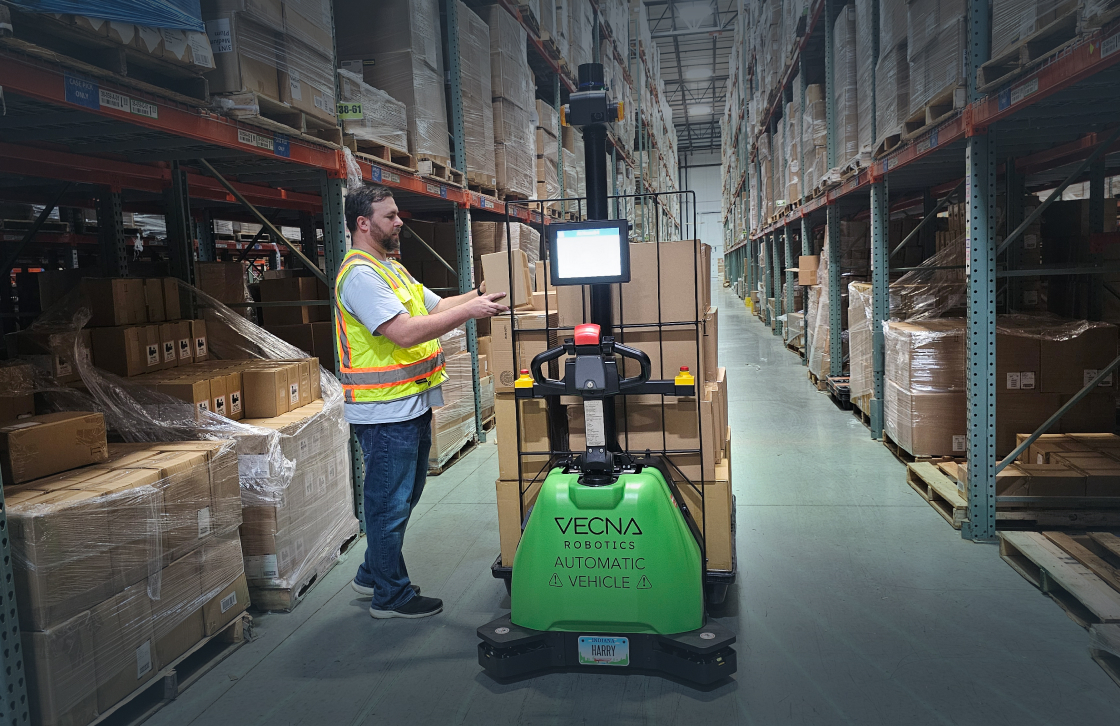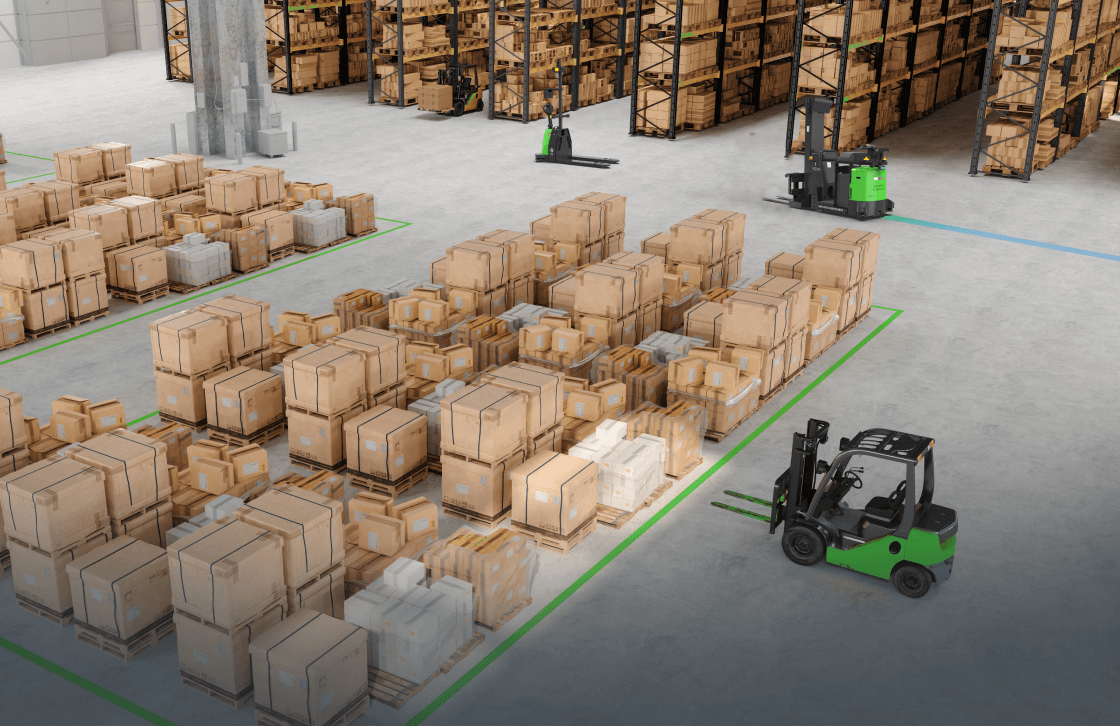Here are six common warehouse mistakes and the automated solutions to address them through technology. Inventory management has always been a complex and challenging task, and current logistics trends are making it more difficult by the day. The rise in e-commerce, globalization, and customer demand for faster delivery has intensified these challenges, pushing traditional manual processes to their limits. Fortunately for warehouse managers, help is available from the ever-evolving world of warehouse automation
1. Failure to optimize picking paths
Labor is the main cost component of a warehouse, with an impact far in excess of many businesses’ calculations. IDC believes warehouses undercount human labor costs by as much as 50%, and picking often accounts for up to 50% of all warehouse labor costs. So optimized operations are essential for minimizing profit loss.
Picking path optimization software is one solution to the problem. Advanced path planning establishes ideal routes for order picking.
Automated mobile robots (AMRs) represent a significant advancement in warehouse technology, specifically designed to improve human picking processes, thereby shortening both picking routes and walking time. Their integration allows for an optimal collaboration between human workers and robots, enhancing warehouse efficiency and speed. For instance, when preparing a grocery order, a human employee can focus on selecting fresh products, utilizing their judgment and expertise, while the robot efficiently picks out the canned and packaged goods. This division of labor not only saves time but also ensures that the best of both human and robotic capabilities are utilized. AMRs can be programmed to follow the most efficient paths, avoid obstacles, and adapt to changes in the warehouse layout. Their utilization can lead to a more flexible and responsive picking process, reducing human fatigue, and increasing overall productivity.
By blending human intuition and decision-making with robotic precision and stamina, warehouses can achieve a synergistic workflow that maximizes the strengths of both parties, leading to quicker fulfillment and higher customer satisfaction.
2. Reliance on manual forklifts
Manual forklifts require fuel, guidance, and human operators. They are dangerous pieces of machinery: it is 90% probable that a forklift will be involved in a severe or fatal accident during its working lifespan. And up to 70% of their total operating costs can be attributed to the driver.
In contrast, driverless forklift AMRs are ready for immediate deployment. They use sensory data: an AMR’s intelligent pallet detection means it can reposition pallets placed askew without human assistance, facilitating effective pallet pick-up. When a pallet is not in the correct drop zone, the robot will search unassisted in nearby zones.
AMRs are designed with advanced navigation capabilities that allow them to move unimpeded by human warehouse mistakes, avoiding obstacles and people, and navigating safely through a warehouse without accidents. Unlike manual forklifts, which can be prone to human error, AMRs operate with a level of precision and consistency that significantly reduces the risk of collisions or damage to goods. Equipped with sensors, cameras, and intelligent algorithms, AMRs constantly scan their surroundings, adapting to unexpected changes in the environment, such as a sudden obstruction or a moving person. Robots are not only a safer alternative to manual forklifts but also contribute to a more organized and streamlined workflow. The automation of tasks traditionally prone to human error leads to a more reliable and efficient operation, minimizing delays, and enhancing overall warehouse safety.
3. Poor inventory tracking
Warehouse mistakes, particularly those that lead to inadequate inventory procedures, can have far-reaching consequences. Errors like incorrect stock levels, obsolete inventory buildup, and disrupted working processes not only increase expenses but also lead to lost revenue and decreased productivity. In a competitive environment, these mistakes can severely affect a business’s ability to meet customer demands and maintain operational efficiency.
However, automation on its own may not be enough to fully address these issues. The advantages of automation can be limited if different functions within the warehouse are isolated from one another. A Warehouse Management System (WMS) serves as a unifying platform that brings together various automation processes, such as inventory tracking, order picking, and shipping. When combined with AMRs equipped with integrated barcode scanning, a WMS can significantly improve inventory accuracy.
AMRs, in particular, can replace laborious manual stock-counting, reducing human errors, and increasing efficiency. They can navigate through aisles, scan barcodes, and update inventory levels in real time. This integration between AMRs and a WMS ensures a coherent and coordinated approach to inventory management, allowing for more accurate KPI tracking and streamlined operations.
4. Substandard safety procedures
A well-organized warehouse is not necessarily safe, and an employee injury sustained during warehouse work can cause litigious problems for the company. If the environment is unsafe, workers will slow down, and productivity will decrease. This not only affects the company’s bottom line but also creates an undesirable work atmosphere that can lead to decreased morale among employees.
AMRs enable the automated transportation of goods, pallets, and other storage units, effectively removing the need for human workers to engage in potentially hazardous tasks such as heavy lifting and navigating through busy warehouse traffic. This efficient labor method not only reduces the risk of accidents but also ensures that employees can focus on more strategic and value-added tasks.
One of the significant advantages of AMRs is their immunity to fatigue. Unlike human workers, who can experience physical and mental exhaustion over time, robots can tirelessly perform physically strenuous tasks without any decline in performance. This not only minimizes the risk of employee injuries caused by overexertion but also maintains consistent productivity levels throughout the work hours.
AMRs are equipped with advanced technologies such as LIDAR (light detection and ranging) units and security cameras, which provide them with a comprehensive 360-degree visibility of their surrounding environment. This heightened situational awareness allows them to navigate through the warehouse space with precision, detecting obstacles in real time and maneuvering around them. Even in demanding 24/7 operational environments, AMRs can reliably avoid collisions, ensuring a safe and efficient workflow at all times.
5. Untrained staff
Without sufficient training, employees often make costly process or safety mistakes, leading to a negative impact on both quality and efficiency within the warehouse. Companies might attribute these errors to budget and time constraints, but the repercussions of accidents resulting from inadequate training can be financially and reputationally detrimental.
Staff turnover exacerbates the situation, imposing significant costs on a company each time an employee departs. The process of training a new employee is not only time-consuming but also expensive. The investment required to bring newcomers up to speed can strain resources, and the learning curve can further disrupt workflow.
Also, by taking on repetitive and hazardous tasks, AMRs mitigate the chances of human error, thus enhancing operational accuracy and safety. Moreover, they offer an innovative approach to staff training. AMRs can serve as guides, assisting workers in navigating the warehouse efficiently and effectively. This not only reduces the likelihood of mistakes but also helps in rapidly acclimating new employees to the warehouse layout and processes.
AMRs also reduce the need for staff overtime. When human workers are unavailable or overworked, AMRs can seamlessly step in to cover the workload, maintaining a consistent level of productivity. This not only prevents employee burnout but also ensures that tasks are completed on time without compromising on quality.
6. Retaining paper processes
Traditional paper-based processes in warehouses often suffer from sluggishness, compounded by the inherent risk of errors due to the involvement of multiple manual steps. Despite these drawbacks, the entrenched practice of relying on paper-based documentation can be resistant to change. Here’s how to upgrade with automation:
- A warehouse management system (WMS) will unify your automation efforts. It acts as the linchpin for your automation efforts, offering a cohesive platform to streamline processes. A notable advantage of WMS is its ability to guide employees through tasks step by step, ensuring consistency and accuracy. WMS also enables seamless access to essential information from any location within the warehouse, boosting operational agility and reducing downtime.
- Handheld devices have emerged as valuable allies in this automation journey. Integrated with WMS systems, these devices facilitate real-time updates and instant visibility into warehouse changes following data input. This instantaneous feedback loop significantly enhances decision-making and provides a dynamic overview of inventory, orders, and processes.
- An automation upgrade doesn’t necessarily entail a complete overhaul of existing systems. It can be as simple as aligning your current practices with warehouse devices that seamlessly integrate with your chosen WMS. Alternatively, a more substantial transformation might involve reimagining and restructuring warehouse processes to fully leverage the benefits of automation.
Put automation to work
Switched-on businesses are exploring and investing in automation and robotics right now. It’s a trend that will only increase — global warehouse automation is on course to double by 2025.
Understand your operational pain points to see where quick automation gains can be achieved. Match those pain points with available resources from automation providers that can offer fast ROI and easy wins; this will help with operational efficiency improvements while also addressing labor shortages.
Cost savings, increased safety, and higher efficiency are undeniable benefits of a carefully planned warehouse automation system, representing a perfect opportunity for you to solve problems fast and thrive in challenging times.
Fortunately, Vecna Robotics has a wide range of material handling solutions that are tailor-made for automating key warehouse workflows right the first time. For more information about how you can get started with your finished goods automation journey, go to our From No-bot to Robot page, or you can contact us today to schedule a consultation with a factory automation expert.





